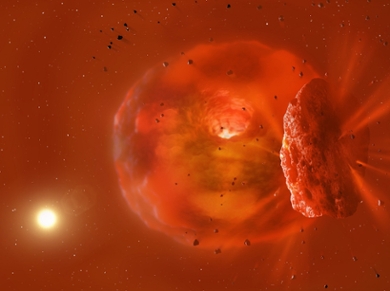Leiden Observatory
Leiden astronomers find building blocks for life in the darkest spots of star-forming cloud
An international team led by Leiden astronomers has found various molecules in space ice in the darkest and coldest regions of a large star-forming cloud. They accomplished this using the James Webb Space Telescope. The discovery shows that the chemical ingredients for larger and complex molecules are already present long before the birth of a new star.
This video can not be shown because you did not accept cookies.
You can leave our website to view this video.Dust cloud from two colliding ice planets dims light of parent star

For the first time, an international group of astronomers have seen the heat glow of two ice giant planets colliding. They could also observe the resultant dust cloud move in front of the parent star several years later. Led by Leiden astronomer Matthew Kenworthy, the astronomers monitored the star’s brightness variations for two years after it began to dim in visible light. Their research is published in the scientific journal Nature.
FLAMINGO: dark matter, ordinary matter, and neutrinos in the biggest cosmological simulation ever
‘Although the dark matter dominates gravity, the contribution of ordinary matter can no longer be neglected.’
Not only dark matter, but also ordinary matter and dark energy are tracked in the largest ever cosmological computer simulation ever. In the FLAMINGO simulations, you can see virtual galaxies and clusters of galaxies emerging over the course of billions of years. This is no easy task: with more than 50 million CPU hours, the simulations required an awful lot of computing power and produced more than 1 petabyte of data. Leiden astronomers and physicists led the project and developed the code.


